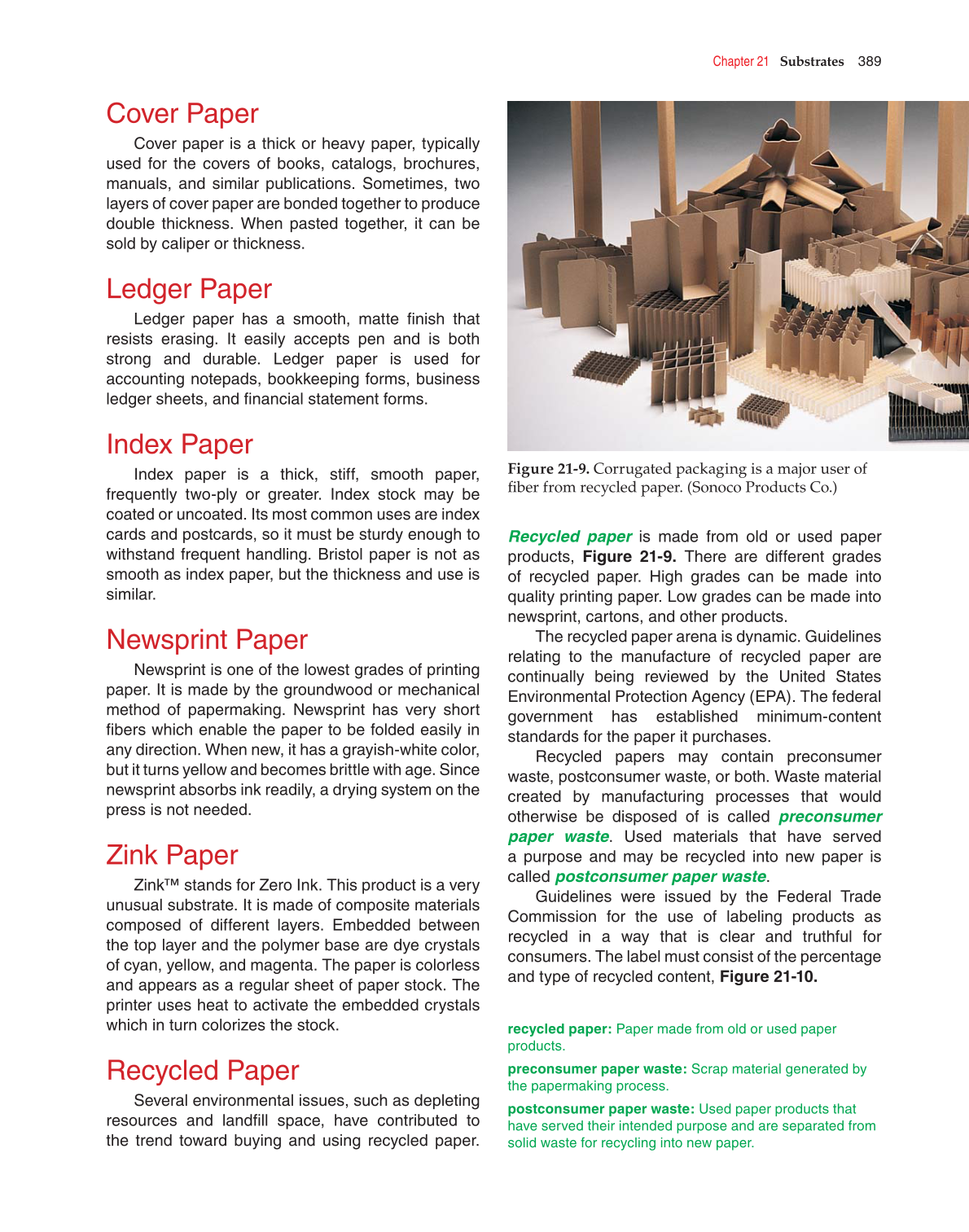Chapter 21 Substrates 389
Cover Paper
Cover paper is a thick or heavy paper, typically
used for the covers of books, catalogs, brochures,
manuals, and similar publications. Sometimes, two
layers of cover paper are bonded together to produce
double thickness. When pasted together, it can be
sold by caliper or thickness.
Ledger Paper
Ledger paper has a smooth, matte fi nish that
resists erasing. It easily accepts pen and is both
strong and durable. Ledger paper is used for
accounting notepads, bookkeeping forms, business
ledger sheets, and fi nancial statement forms.
Index Paper
Index paper is a thick, stiff, smooth paper,
frequently two-ply or greater. Index stock may be
coated or uncoated. Its most common uses are index
cards and postcards, so it must be sturdy enough to
withstand frequent handling. Bristol paper is not as
smooth as index paper, but the thickness and use is
similar.
Newsprint Paper
Newsprint is one of the lowest grades of printing
paper. It is made by the groundwood or mechanical
method of papermaking. Newsprint has very short
fi bers which enable the paper to be folded easily in
any direction. When new, it has a grayish-white color,
but it turns yellow and becomes brittle with age. Since
newsprint absorbs ink readily, a drying system on the
press is not needed.
Zink Paper
Zink™ stands for Zero Ink. This product is a very
unusual substrate. It is made of composite materials
composed of different layers. Embedded between
the top layer and the polymer base are dye crystals
of cyan, yellow, and magenta. The paper is colorless
and appears as a regular sheet of paper stock. The
printer uses heat to activate the embedded crystals
which in turn colorizes the stock.
Recycled Paper
Several environmental issues, such as depleting
resources and landfi ll space, have contributed to
the trend toward buying and using recycled paper.
Recycled paper is made from old or used paper
products, Figure 21-9. There are different grades
of recycled paper. High grades can be made into
quality printing paper. Low grades can be made into
newsprint, cartons, and other products.
The recycled paper arena is dynamic. Guidelines
relating to the manufacture of recycled paper are
continually being reviewed by the United States
Environmental Protection Agency (EPA). The federal
government has established minimum-content
standards for the paper it purchases.
Recycled papers may contain preconsumer
waste, postconsumer waste, or both. Waste material
created by manufacturing processes that would
otherwise be disposed of is called preconsumer
paper waste. Used materials that have served
a purpose and may be recycled into new paper is
called postconsumer paper waste.
Guidelines were issued by the Federal Trade
Commission for the use of labeling products as
recycled in a way that is clear and truthful for
consumers. The label must consist of the percentage
and type of recycled content, Figure 21-10.
Figure 21-9. Corrugated packaging is a major user of
fi ber from recycled paper. (Sonoco Products Co.)
recycled paper: Paper made from old or used paper
products.
preconsumer paper waste: Scrap material generated by
the papermaking process.
postconsumer paper waste: Used paper products that
have served their intended purpose and are separated from
solid waste for recycling into new paper.
